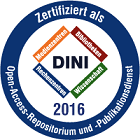Rossi Piva, Maria Bethania: The impact and underlying molecular mechanisms of cell adhesion molecules integrins and syndecans in the cisplatin chemoresistance of melanoma cells. - Bonn, 2019. - Dissertation, Rheinische Friedrich-Wilhelms-Universität Bonn.
Online-Ausgabe in bonndoc: https://nbn-resolving.org/urn:nbn:de:hbz:5n-56724
Online-Ausgabe in bonndoc: https://nbn-resolving.org/urn:nbn:de:hbz:5n-56724
@phdthesis{handle:20.500.11811/8121,
urn: https://nbn-resolving.org/urn:nbn:de:hbz:5n-56724,
author = {{Maria Bethania Rossi Piva}},
title = {The impact and underlying molecular mechanisms of cell adhesion molecules integrins and syndecans in the cisplatin chemoresistance of melanoma cells},
school = {Rheinische Friedrich-Wilhelms-Universität Bonn},
year = 2019,
month = dec,
note = {Cancer is a complex, but also devastating disease, which today, more than ever, is present in our lives and society. Practically every person has a close relative or friend, or has been themselves affected by this disease. Although the incidence of cancer has been increasing rapidly, it is not a modern illness. Cancer has been detected in several archaeological findings, from dinosaurs to mummies (1–3). Most recently, in February 2019, a report was published about the oldest indication of cancer ever found in vertebrates. It describes the finding of osteosarcoma in a Middle Triassic stem-turtle (1). As discussed in the article, the reason why this disease can be found virtually from the beginning of life, is because it is an unfortunate side effect of cell development during life and evolution (1). The authors of the paper put it most adequately, in my opinion, as they say: "Cancer is not a modern physiological defect but rather a vulnerability that is deeply rooted in vertebrate evolutionary history" (1).
Cells are constantly renewing, dividing and adapting themselves to survive. These adaptations can provide an evolutionary advantage and, sometimes, be passed on and change the species. However, sometimes mistakes occur that lead cells to lose replication control and cancer arises. The fact that cancer arises from errors or changes during cell development makes it very complex, adaptable and difficult to understand and treat. This complexity can be observed in the different tissues, types and sub-types of the disease, which often manifest themselves as almost completely different entities, with different causes, development and outcomes. Moreover, the fact that it is your body attacking itself, and not a foreign organism, makes it difficult to detect and treat, but also hard for patients and society to understand and accept it. Curiously, cancer findings in fossils are a rare discovery, one of the reasons for this is the degradation of soft tissue in time, which makes detection in these tissues impossible (1). Other reasons are environmental and genetic changes.
As constant technological developments have, on one hand, increased our lifespan allowing for more cell replication and stress exposure, which increases the chances of mutation. On the other hand, they put us in contact with carcinogens such as growth hormones, pesticides, pollution and radiation that contribute for an increased incidence of cancer. Moreover, better understanding and diagnostics tools allow cancer patients to be identified more often and rapidly than ever.
One of the environmental causes for cancer is radiation, such as, for example, solar UV light, which is one of the main causes of malignant melanoma, one of the most aggressive malignancies in humans (4). It has a high incidence worldwide, which is unfortunately expected to increase, with a global mortality rate of 20% (5). Case numbers can be correlated with tropical, sunny regions and ozone layer holes, as is the case of Australia, as well as phenotypic features such as pale white skin, blond or red hair and blue eyes, and familial history (4,6,7). Since skin cells are designed to have a protective role, they are very adaptable and resistant to apoptosis induced by DNA mutation, characteristics which are preserved in and often used by malignant cells for their survival (6). Therefore, the malignant transformation, metastasis and drug-resistance development that follows are all complex, multifactorial processes dependent on many variables, which present tremendous challenges for the development of curative therapy. Although there have been many therapeutic improvements, most drugs only interfere with the growth of primary tumours (8–10). As a result, patients develop metastatic melanoma, which is one of the most aggressive and drug resistant neoplasm that sadly leads to death in the majority of cases, usually due to resistance to treatment (4).
Resistance development is a complex, multipart process, not yet fully understood. In this work our main interest is the environment-mediated drug resistance (EM-DR), which is an innate, transient protective effect that the microenvironment provides to cells. It is an important phenomenon because it allows for the development of acquired drug resistance, i.e. genetic adaptations in response to prolonged therapy.
One type of EM-DR is cell adhesion-mediated drug resistance (CAM-DR), which is mediated by the attachment of cell membrane proteins, such as integrins and syndecans, to components of the extracellular matrix (ECM), which triggers survival cell-signalling pathways. The mitogen-activated protein kinase (MAPK) pathway has been associated with melanoma development, progression and resistance and intensively studied (11,12). For this reason, we decided to focus this work in the study of an associated but less studied pathway in melanoma, the FAK/PI3K/AKT signalling pathway, which is also known to lead to cell survival.
With this purpose, we have investigated the sensitivity of melanoma cells to cisplatin treatment under different integrin-activating experimental conditions. Cells were seeded on surfaces coated with ECM components - fibronectin and collagen - and treated with Mn2+; a known integrin activator, previously to cisplatin addition. A PI3K/mTOR inhibitor was also used, in order to interfere in cell signalling. After the treatments, cell sensitivity to cisplatin was evaluated using a colorimetric cytotoxicity test. Moreover, β1 integrin-deficient cells were generated and tested, together with syndecan-4 knockdown cells, with the purpose of assessing the importance of these adhesion molecules for the cells in the context of cisplatin resistance. Finally, the activation of the FAK/PI3K/AKT signalling pathway was observed under these experimental conditions through flow cytometry.
This work provides a view into one of the CAM-DR mechanisms used by melanoma cells to protect themselves from cisplatin stress. It shows the importance of integrins, syndecans and the ECM in this context, as well as in cell plasticity and the complexities of resistance formation.},
url = {https://hdl.handle.net/20.500.11811/8121}
}
urn: https://nbn-resolving.org/urn:nbn:de:hbz:5n-56724,
author = {{Maria Bethania Rossi Piva}},
title = {The impact and underlying molecular mechanisms of cell adhesion molecules integrins and syndecans in the cisplatin chemoresistance of melanoma cells},
school = {Rheinische Friedrich-Wilhelms-Universität Bonn},
year = 2019,
month = dec,
note = {Cancer is a complex, but also devastating disease, which today, more than ever, is present in our lives and society. Practically every person has a close relative or friend, or has been themselves affected by this disease. Although the incidence of cancer has been increasing rapidly, it is not a modern illness. Cancer has been detected in several archaeological findings, from dinosaurs to mummies (1–3). Most recently, in February 2019, a report was published about the oldest indication of cancer ever found in vertebrates. It describes the finding of osteosarcoma in a Middle Triassic stem-turtle (1). As discussed in the article, the reason why this disease can be found virtually from the beginning of life, is because it is an unfortunate side effect of cell development during life and evolution (1). The authors of the paper put it most adequately, in my opinion, as they say: "Cancer is not a modern physiological defect but rather a vulnerability that is deeply rooted in vertebrate evolutionary history" (1).
Cells are constantly renewing, dividing and adapting themselves to survive. These adaptations can provide an evolutionary advantage and, sometimes, be passed on and change the species. However, sometimes mistakes occur that lead cells to lose replication control and cancer arises. The fact that cancer arises from errors or changes during cell development makes it very complex, adaptable and difficult to understand and treat. This complexity can be observed in the different tissues, types and sub-types of the disease, which often manifest themselves as almost completely different entities, with different causes, development and outcomes. Moreover, the fact that it is your body attacking itself, and not a foreign organism, makes it difficult to detect and treat, but also hard for patients and society to understand and accept it. Curiously, cancer findings in fossils are a rare discovery, one of the reasons for this is the degradation of soft tissue in time, which makes detection in these tissues impossible (1). Other reasons are environmental and genetic changes.
As constant technological developments have, on one hand, increased our lifespan allowing for more cell replication and stress exposure, which increases the chances of mutation. On the other hand, they put us in contact with carcinogens such as growth hormones, pesticides, pollution and radiation that contribute for an increased incidence of cancer. Moreover, better understanding and diagnostics tools allow cancer patients to be identified more often and rapidly than ever.
One of the environmental causes for cancer is radiation, such as, for example, solar UV light, which is one of the main causes of malignant melanoma, one of the most aggressive malignancies in humans (4). It has a high incidence worldwide, which is unfortunately expected to increase, with a global mortality rate of 20% (5). Case numbers can be correlated with tropical, sunny regions and ozone layer holes, as is the case of Australia, as well as phenotypic features such as pale white skin, blond or red hair and blue eyes, and familial history (4,6,7). Since skin cells are designed to have a protective role, they are very adaptable and resistant to apoptosis induced by DNA mutation, characteristics which are preserved in and often used by malignant cells for their survival (6). Therefore, the malignant transformation, metastasis and drug-resistance development that follows are all complex, multifactorial processes dependent on many variables, which present tremendous challenges for the development of curative therapy. Although there have been many therapeutic improvements, most drugs only interfere with the growth of primary tumours (8–10). As a result, patients develop metastatic melanoma, which is one of the most aggressive and drug resistant neoplasm that sadly leads to death in the majority of cases, usually due to resistance to treatment (4).
Resistance development is a complex, multipart process, not yet fully understood. In this work our main interest is the environment-mediated drug resistance (EM-DR), which is an innate, transient protective effect that the microenvironment provides to cells. It is an important phenomenon because it allows for the development of acquired drug resistance, i.e. genetic adaptations in response to prolonged therapy.
One type of EM-DR is cell adhesion-mediated drug resistance (CAM-DR), which is mediated by the attachment of cell membrane proteins, such as integrins and syndecans, to components of the extracellular matrix (ECM), which triggers survival cell-signalling pathways. The mitogen-activated protein kinase (MAPK) pathway has been associated with melanoma development, progression and resistance and intensively studied (11,12). For this reason, we decided to focus this work in the study of an associated but less studied pathway in melanoma, the FAK/PI3K/AKT signalling pathway, which is also known to lead to cell survival.
With this purpose, we have investigated the sensitivity of melanoma cells to cisplatin treatment under different integrin-activating experimental conditions. Cells were seeded on surfaces coated with ECM components - fibronectin and collagen - and treated with Mn2+; a known integrin activator, previously to cisplatin addition. A PI3K/mTOR inhibitor was also used, in order to interfere in cell signalling. After the treatments, cell sensitivity to cisplatin was evaluated using a colorimetric cytotoxicity test. Moreover, β1 integrin-deficient cells were generated and tested, together with syndecan-4 knockdown cells, with the purpose of assessing the importance of these adhesion molecules for the cells in the context of cisplatin resistance. Finally, the activation of the FAK/PI3K/AKT signalling pathway was observed under these experimental conditions through flow cytometry.
This work provides a view into one of the CAM-DR mechanisms used by melanoma cells to protect themselves from cisplatin stress. It shows the importance of integrins, syndecans and the ECM in this context, as well as in cell plasticity and the complexities of resistance formation.},
url = {https://hdl.handle.net/20.500.11811/8121}
}






